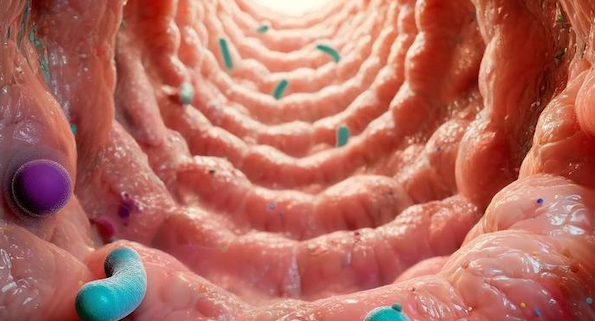The Pathogens Behind Inflammatory Bowel Disease (IBD)
Over 2 million Americans suffer from chronic inflammatory bowel disease (IBD) which includes Crohn’s disease and Ulcerative colitis [1, 2]. These patients experience debilitating digestive symptoms like persistent diarrhea, rectal bleeding, and abdominal pain resulting in a detrimental impact on quality of life. While the exact cause of IBD is not fully understood, there is now overwhelming evidence that gut microbiota contributes to the aberrant immune response in genetically susceptible patients. In this article, we will present the evidence in three different layers.
1. Altered gut microbiome composition in IBD patients
Several studies have found elevated levels of E. coli and Klebsiella pneumoniae in the gut microbiome of IBD patients.
- Colombel et al showed that E. coli strains are abnormally predominant in early and chronic ileal lesions of patients with Crohn’s disease [3].
- Khorsand et al performed metagenome wide association studies on fecal samples of 191 CD patients, 132 UC patients, and 125 healthy controls [4]. They found that taxonomic and functional composition of intestinal bacteria in CD and UC patients was significantly shifted to Enterobacteriaceae species.
- Mirsepasi et al found that adherent invasive E. coli (AIEC) were linked to Crohn’s while diffusely adherent E. coli (DAEC) were associated with Ulcerative Colitis [5].
- Pisani et al analyzed stool samples of 98 IBD patients in a state of remission using 16S rRNA sequencing and found that IBD patients had reduced diversity and increased Enterobacteriaceae which could act as drivers of residual inflammatory process even in a state of low disease activity.
- Kharaghani et al analyzed inflamed colonic biopsies in 83 IBD patients and found E. coli and Klebsiella pneumoniae in the majority of them [6].
- Rashid et al collected data from six different gastroenterology centers in the UK and reported elevated levels of antibodies to Klebsiella in Crohn’s disease patients [7].
- Gevers et al used samples from multiple gastrointestinal locations and found increased abundance of Enterobacteriaceae in patients with Crohn’s disease. They also found that past antibiotic use amplified the dysbiosis associated with Crohn’s disease [8].
- Kotlowski et al sequenced 84 biopsy specimens from IBD patients and found that abundance of Enterobacteriaceae is 3-4 logs higher in tissues of patients with IBD [9].
2. Transfer of dysbiotic microbes in animal models triggers inflammation.
Going beyond association of Enterobacteriaceae in IBD patients, several studies transferred dysbiotic microbes to mice and demonstrated that these microbes induce and exacerbate IBD.
- Kittana et al compared adherent invasive E. coli with the commensal E. coli by transferring them in IBD mice models and found that AIEC cause severe inflammation [10].
- Chassaing et al inoculated both germ free mice (WT) and genetically susceptible mice (T5KO) with an AIEC strain. They noticed that AIEC strain caused chronic inflammation only in the genetically susceptible mice [11].
- Zhang et al used a strain of Klebsiella Pneumoniae in several genetically modified mice to demonstrate exact mechanism of how Klebsiella can colonize the colon, activate caspase-11 inflammasomes, and contribute to intestinal inflammation [12]
- Yang et al used ulcerative colitis associated E. coli pathobionts to show that UC pathobionts adhere to intestinal mucosa and worsen the course of colitis in susceptible hosts [13].
- Lin et al used a strain of Klebsiella variicola and showed that it can induce Th1 cells and inhibit Treg differentiation to promote intestinal inflammation as measured by well established markers of IBD [14].
- Carvalho et al demonstrated that AIEC bacteria induced severe colitis with reduced survival rate, marked weight loss, increased rectal bleeding, mucosal inflammation and increased proinflammatory cytokine expression. At the same time, non-pathogenic E. coli K12 strain did not lead to colitis [15]
3. Improvement in disease symptoms by reducing harmful bacteria
Finally, as another layer of proof, reduction of E. coli and Klebsiella through multiple independent approaches including antibiotics, small molecule therapeutics, and bacteriophages lead to improvement in intestinal inflammation as measured in animal models.
- Galtier et al used bacteriophages to reduce AIEC in mice and demonstrated that the reduction reduces colitis symptoms [16].
- Federici et al used a cocktail of five bacteriophages to reduce Klebsiella pneumoniae and suppress intestinal inflammation in animal models [17].
- Zhu et al used an innovative tungstate treatment to prevent dysbiotic expansion of Enterobacteriaceae and demonstrated it reduced severity of inflammation in mice models of colitis [18].
Our Approach
The challenge in using bacteriophages for real world application is that they have a high specificity to the target bacterial strain and therefore can not comprehensively reduce a wide spectrum of bacteria across a diverse patient population. On the other hand, broad spectrum antibiotics promote the proliferation of Enterobacteriaceae which is the opposite of what is required. An ideal therapeutic would only target the Enterobacteriaceae, and create an environment for healthy firmicutes to flourish. This is what we are developing at Gutbiotics.
REFERENCES
1. Lewis JD, Parlett LE, Funk MLJ, Brensinger C, Pate V, Wu Q, et al. Incidence, Prevalence, and Racial and Ethnic Distribution of Inflammatory Bowel Disease in the United States. Gastroenterology. 2023 Nov 1;165(5):1197-1205.e2.
2. Weisman MH, Oleg Stens, Seok Kim H, Hou JK, Miller FW, Dillon CF. Inflammatory Bowel Disease Prevalence: Surveillance data from the U.S. National Health and Nutrition Examination Survey. Prev Med Rep. 2023 Mar 9;33:102173.
3. Darfeuille-Michaud A, Neut C, Barnich N, Lederman E, Di Martino P, Desreumaux P, et al. Presence of adherent Escherichia coli strains in ileal mucosa of patients with Crohn’s disease. Gastroenterology. 1998 Dec;115(6):1405–13.
4. Khorsand B, Asadzadeh Aghdaei H, Nazemalhosseini-Mojarad E, Nadalian B, Nadalian B, Houri H. Overrepresentation of Enterobacteriaceae and Escherichia coli is the major gut microbiome signature in Crohn’s disease and ulcerative colitis; a comprehensive metagenomic analysis of IBDMDB datasets.
5. Mirsepasi-Lauridsen HC, Vallance BA, Krogfelt KA, Petersen AM. Escherichia coli Pathobionts Associated with Inflammatory Bowel Disease. Clin Microbiol Rev. 2019 Jan 30;32(2):10.1128/cmr.00060-18.
6. Kharaghani AA, Harzandi N, Khorsand B, Rajabnia M, Kharaghani AA, Houri H. High prevalence of Mucosa-Associated extended-spectrum β-Lactamase-producing Escherichia coli and Klebsiella pneumoniae among Iranain patients with inflammatory bowel disease (IBD). Ann Clin Microbiol Antimicrob. 2023 Sep 14;22(1):86.
7. Rashid T, Ebringer A, Wilson C. The Role of Klebsiella in Crohn’s Disease with a Potential for the Use of Antimicrobial Measures. Int J Rheumatol. 2013;2013:610393.
8. Gevers D, Kugathasan S, Denson LA, Vázquez-Baeza Y, Van Treuren W, Ren B, et al. The Treatment-Naive Microbiome in New-Onset Crohn’s Disease. Cell Host Microbe. 2014 Mar;15(3):382–92.
9. Kotlowski R, Bernstein CN, Sepehri S, Krause DO. High prevalence of Escherichia coli belonging to the B2+D phylogenetic group in inflammatory bowel disease. Gut. 2007 May;56(5):669–75.
10. Kittana H, Gomes-Neto JC, Heck K, Juritsch AF, Sughroue J, Xian Y, et al. Evidence for a Causal Role for Escherichia coli Strains Identified as Adherent-Invasive (AIEC) in Intestinal Inflammation. mSphere. 2023 Mar 8;8(2):e00478-22.
11. Chassaing B, Koren O, Carvalho FA, Ley RE, Gewirtz AT. AIEC Pathobiont Instigates Chronic colitis in Susceptible Hosts by Altering Microbiota composition. Gut. 2014 Jul;63(7):1069–80.
12. Zhang Q, Su X, Zhang C, Chen W, Wang Y, Yang X, et al. Klebsiella pneumoniae Induces Inflammatory Bowel Disease Through Caspase-11–Mediated IL18 in the Gut Epithelial Cells. Cell Mol Gastroenterol Hepatol. 2022 Nov 25;15(3):613–32.
13. Yang H, Mirsepasi-Lauridsen HC, Struve C, Allaire JM, Sivignon A, Vogl W, et al. Ulcerative Colitis-associated E. coli pathobionts potentiate colitis in susceptible hosts. Gut Microbes. 2020 Nov 9;12(1):1847976.
14. Lin H, Wang Q, Liu L, Chen Z, Das R, Zhao Y, et al. Colonization of Mice With Amoxicillin-Associated Klebsiella variicola Drives Inflammation via Th1 Induction and Treg Inhibition. Front Microbiol [Internet]. 2020 [cited 2024 Jan 27];11. Available from: https://www.frontiersin.org/articles/10.3389/fmicb.2020.01256
15. Carvalho FA, Barnich N, Sivignon A, Darcha C, Chan CHF, Stanners CP, et al. Crohn’s disease adherent-invasive Escherichia coli colonize and induce strong gut inflammation in transgenic mice expressing human CEACAM. J Exp Med. 2009 Sep 8;206(10):2179–89.
16. Galtier M, Sordi LD, Sivignon A, de Vallée A, Maura D, Neut C, et al. Bacteriophages Targeting Adherent Invasive Escherichia coli Strains as a Promising New Treatment for Crohn’s Disease. J Crohns Colitis. 2017 Jul 1;11(7):840–7.
17. Federici S, Kredo-Russo S, Valdés-Mas R, Kviatcovsky D, Weinstock E, Matiuhin Y, et al. Targeted suppression of human IBD-associated gut microbiota commensals by phage consortia for treatment of intestinal inflammation. Cell. 2022 Aug 4;185(16):2879-2898.e24.
18. Zhu W, Winter MG, Byndloss MX, Spiga L, Duerkop BA, Hughes ER, et al. Precision editing of the gut microbiota ameliorates colitis. Nature. 2018 Jan;553(7687):208–11.

